Effect of Superabsorbent Polymers on the Self-Healing Properties of Pre-Damaged Concrete
Abstract
1. Introduction
2. Materials and Methods
2.1. Raw Materials
2.2. Sample Preparation
2.3. Test Methods
2.3.1. Compressive Strength Test
2.3.2. Flexural Strength Test
2.3.3. Self-Healing Performance Test
2.3.4. Pore Structure Analysis
2.3.5. Microstructural Analysis
3. Results and Discussion
3.1. Mechanical Property
3.1.1. Compressive Strength
3.1.2. Flexural Strength
3.1.3. The Mechanical Properties of Self-Healing
3.2. Pore Structure
3.2.1. Porosity
3.2.2. Pore Diameter Distribution
3.2.3. Compressive Strength–Porosity Relationship Representation by Balshin Equation
3.3. Microstructure
3.3.1. SEM Analysis
3.3.2. EDS Analysis
4. Conclusions
- (1)
- SAP reduces the mechanical properties of SAP-modified concrete under the same W/C ratio. However, a small amount of SAP can improve the later strength when the W/C ratio is under 0.35.
- (2)
- The lower the W/C ratio, the more mechanical property is influenced by the addition of SAP, and this effect is more pronounced at an early age.
- (3)
- After 28 d of curing, the UCS of the pre-damaged sample is generally lower than that of the non-damaged sample, except for with the addition of 0.25% SAP.
- (4)
- The addition of SAP increases the volume of the small capillary pores (<20 μm) and large capillary pores (>100 μm), and significantly reduces the former with the increase in age.
- (5)
- The water released by SAP promotes the formation of C-S-H gel, and AFt in cracks is the main reason for cement self-healing. CO2 enters the cracks and combines with Ca(OH)2 to produce calcium carbonate (CaCO3), which is another reason.
- (6)
- The SAP-modified concrete has the best self-healing effect and the densest structure, when the W/C ratio is 0.35 and the SAP content is 0.25%.
Author Contributions
Funding
Institutional Review Board Statement
Informed Consent Statement
Data Availability Statement
Conflicts of Interest
References
- Wang, X.; Liu, L.; Fu, R.; Sun, X. Newly developed pressure adaptable concrete lining for high pressure hydraulic tunnels. Tunn. Undergr. Space Technol. 2020, 105, 103570. [Google Scholar] [CrossRef]
- Yang, L.; Yao, Z.; Xue, W.; Wang, X.; Kong, W.; Wu, T. Preparation, performance test and microanalysis of hybrid fibers and microexpansive high-performance shaft lining concrete. Constr. Build. Mater. 2019, 223, 431–440. [Google Scholar] [CrossRef]
- Cugat, V.; Cavalaro, S.; Bairán, J.; de la Fuente, A. Safety format for the flexural design of tunnel fibre reinforced concrete precast segmental linings. Tunn. Undergr. Space Technol. 2020, 103, 103500. [Google Scholar] [CrossRef]
- Wu, M.; Hu, X.; Zhang, Q.; Cheng, W.; Xue, D.; Zhao, Y. Application of bacterial spores coated by a green inorganic cementitious material for the self-healing of concrete cracks. Cem. Concr. Compos. 2020, 113, 103718. [Google Scholar] [CrossRef]
- García, R.; Pérez Caldentey, A. Influence of type of loading (tension or bending) on cracking behaviour of reinforced concrete elements. Experimental study. Eng. Struct. 2020, 222, 111134. [Google Scholar] [CrossRef]
- Lawrence, P.; Cyr, M.; Ringot, E. Mineral admixtures in mortars: Effect of inert materials on short-term hydration. Cem. Concr. Res. 2003, 33, 1939–1947. [Google Scholar] [CrossRef]
- Li, Z.; Ding, S.; Yu, X.; Han, B.; Ou, J. Multifunctional cementitious composites modified with nano titanium dioxide: A review. Compos. Part A Appl. Sci. Manuf. 2018, 111, 115–137. [Google Scholar] [CrossRef]
- Wang, K.; Jansen, D.C.; Shah, S.P.; Karr, A.F. Permeability study of cracked concrete. Cem. Concr. Res. 1997, 27, 381–393. [Google Scholar] [CrossRef]
- Ray, I.; Parish, G.C.; Davalos, J.F.; Chen, A. Effect of Concrete Substrate Repair Methods for Beams Aged by Accelerated Corrosion and Strengthened with CFRP. J. Aerospace. Eng. 2011, 24, 227–239. [Google Scholar] [CrossRef]
- Nobili, A.; Falope, F.O. Impregnated Carbon Fabric-Reinforced Cementitious Matrix Composite for Rehabilitation of the Finale Emilia Hospital Roofs: Case Study. J. Compos. Constr. 2017, 21, 050170014. [Google Scholar] [CrossRef]
- He, Z.; Shen, A.; Guo, Y.; Lyu, Z.; Li, D.; Qin, X.; Zhao, M.; Wang, Z. Cement-based materials modified with superabsorbent polymers: A review. Constr. Build. Mater. 2019, 225, 569–590. [Google Scholar] [CrossRef]
- Ma, X.; Zhang, J.; Liu, J. Review on Superabsorbent Polymer as Internal Curing Agent of High Performance Cement-based Material. J. Chin. Ceram. Soc. 2015, 43, 1099–1110. [Google Scholar]
- Dutkiewicz, J.K. Superabsorbent materials from shellfish waste? A review. J. Biomed. Mater. Res. 2002, 63, 373–381. [Google Scholar] [CrossRef]
- Mignon, A.; Snoeck, D.; Halluin, K.; Balcaen, L.; Vanhaecke, F.; Dubruel, P.; Vlierberghe, S.V.; Belie, N.D. Alginate biopolymers: Counteracting the impact of superabsorbent polymers on mortar strength. Constr. Build. Mater. 2016, 110, 169–174. [Google Scholar] [CrossRef]
- Riyazi, S.; Kevern, J.T.; Mulheron, M. Super absorbent polymers (SAPs) as physical air entrainment in cement mortars. Constr. Build. Mater. 2017, 147, 669–676. [Google Scholar] [CrossRef]
- Jensen, O.M.; Hansen, P.F. Water-entrained cement-based materials: I. Principles and theoretical background. Cem. Concr. Res. 2001, 31, 647–654. [Google Scholar] [CrossRef]
- Hasholt, M.T.; Jensen, O.M.; Kovler, K.; Zhutovsky, S. Can superabsorent polymers mitigate autogenous shrinkage of internally cured concrete without compromising the strength? Constr. Build. Mater. 2012, 31, 226–230. [Google Scholar] [CrossRef]
- Snoeck, D.; Schaubroeck, D.; Dubruel, P.; De Belie, N. Effect of high amounts of superabsorbent polymers and additional water on the workability, microstructure and strength of mortars with a water-to-cement ratio of 0.50. Constr. Build. Mater. 2014, 72, 148–157. [Google Scholar] [CrossRef]
- Snoeck, D.; Steuperaert, S.; Van Tittelboom, K.; Dubruel, P.; De Belie, N. Visualization of water penetration in cementitious materials with superabsorbent polymers by means of neutron radiography. Cem. Concr. Res. 2012, 42, 1113–1121. [Google Scholar] [CrossRef]
- De Rooij, M.; Van Tittelboom, K.; De Belie, N.; Schlangen, E. State-of-the-Art Report of RILEM Technical Com-mittee 221-SHC: Self-Healing Phenomena in Cement-Based Materials; Springer: Berlin/Heidelberg, Germany, 2013. [Google Scholar]
- Hong, G.; Choi, S. Modeling rapid self-sealing of cracks in cementitious materials using superabsorbent polymers. Constr. Build. Mater. 2018, 164, 570–578. [Google Scholar] [CrossRef]
- Lee, H.; Wong, H.; Buenfeld, N. Self-sealing of cracks in concrete using superabsorbent polymers. Cem. Concr. Res. 2016, 79, 194–208. [Google Scholar] [CrossRef]
- Snoeck, D.; Van Tittelboom, K.; Steuperaert, S.; Dubruel, P.; De Belie, N. Self-healing cementitious materials by the combination of microfibres and superabsorbent polymers. J. Intell. Mater. Syst. Struct. 2014, 25, 13–24. [Google Scholar] [CrossRef]
- Ma, X.; Liu, J.; Wu, Z.; Shi, C. Effects of SAP on the properties and pore structure of high performance cement-based materials. Constr. Build. Mater. 2017, 131, 476–484. [Google Scholar] [CrossRef]
- Kang, S.; Hong, S.; Moon, J. The effect of superabsorbent polymer on various scale of pore structure in ultra-high performance concrete. Constr. Build. Mater. 2018, 172, 29–40. [Google Scholar] [CrossRef]
- Li, M.; Wang, Y.-J.; Wang, W.-B.; Tian, Q.; Liu, J.-P. Quantitative characterisation of absorption capacity and dosage of SAP in cement paste. Adv. Cem. Res. 2016, 28, 518–528. [Google Scholar] [CrossRef]
- Mignon, A.; Vagenende, M.; Martins, J.; Dubruel, P.; Van Vlierberghe, S.; De Belie, N. Development of amine-based pH-responsive superabsorbent polymers for mortar applications. Constr. Build. Mater. 2017, 132, 556–564. [Google Scholar] [CrossRef]
- Beushausen, H.; Gillmer, M. The use of superabsorbent polymers to reduce cracking of bonded mortar overlays. Cem. Concr. Compos. 2014, 52, 1–8. [Google Scholar] [CrossRef]
- Nestle, N.; Kühn, A.; Friedemann, K.; Horch, C.; Stallmach, F.; Herth, G. Water balance and pore structure development in cementitious materials in internal curing with modified superabsorbent polymer studied by NMR. Microporous Mesoporous Mater. 2009, 125, 51–57. [Google Scholar] [CrossRef]
- Schröfl, C.; Mechtcherine, V.; Gorges, M. Relation between the molecular structure and the efficiency of superabsorbent polymers (SAP) as concrete admixture to mitigate autogenous shrinkage. Cem. Concr. Res. 2012, 42, 865–873. [Google Scholar] [CrossRef]
- Jensen, O.M.; Hansen, P.F. Water-entrained cement-based materials II. Experimental observations. Cem. Concr. Res. 2002, 32, 973–978. [Google Scholar] [CrossRef]
- Dudziak, L.; Mechtcherine, V. Enhancing early-age resistance to cracking in high-strength cement-based materials by means of internal curing using super absorbent polymers. In International RILEM Conference on Material Science 2010, Aachen, Germany, 6–8 September 2010; Brameshuber, W., Ed.; RILEM Publications: Marne la Vallée, France, 2010; pp. 129–139. [Google Scholar]
- Gupta, S.; Kua, H.W.; Pang, S.D. Combination of polypropylene fibre and superabsorbent polymer to improve physical properties of cement mortar. Mag. Concr. Res. 2018, 70, 350–364. [Google Scholar] [CrossRef]
- Olawuyi, B.J.; Boshoff, W. Influence of SAP content and curing age on air void distribution of high performance concrete using 3D volume analysis. Constr. Build. Mater. 2017, 135, 580–589. [Google Scholar] [CrossRef]
- Hajimohammadi, A.; Ngo, T.; Mendis, P. Enhancing the strength of pre-made foams for foam concrete applications. Cem. Concr. Compos. 2018, 87, 164–171. [Google Scholar] [CrossRef]
- Nambiar, E.K.K.; Ramamurthy, K. Models for strength prediction of foam concrete. Mater. Struct. 2008, 41, 247–254. [Google Scholar] [CrossRef]
- Kearsley, E.P.; Wainwright, P.J. The effect of porosity on the strength of foamed concrete. Cem. Concr. Res. 2002, 32, 233–239. [Google Scholar] [CrossRef]
- Diamond, S. Mercury porosimetry: An inappropriate method for the measurement of pore size distributions in cement-based materials. Cem. Concr. Res. 2000, 30, 1517–1525. [Google Scholar] [CrossRef]
- Meddah, M.S.; Tagnit-Hamou, A. Pore Structure of Concrete with Mineral Admixtures and Its Effect on Self-Desiccation Shrinkage. ACI Mater. J. 2009, 106, 241–250. [Google Scholar]
- Dang, J.; Zhao, J.; Du, Z. Effect of Superabsorbent Polymer on the Properties of Concrete. Polymers 2017, 9, 672. [Google Scholar] [CrossRef]
- Justs, J.; Wyrzykowski, M.; Winnefeld, F.; Bajare, D.; Lura, P. Influence of superabsorbent polymers on hydration of cement pastes with low water-to-binder ratio. J. Therm. Anal. 2014, 115, 425–432. [Google Scholar] [CrossRef]

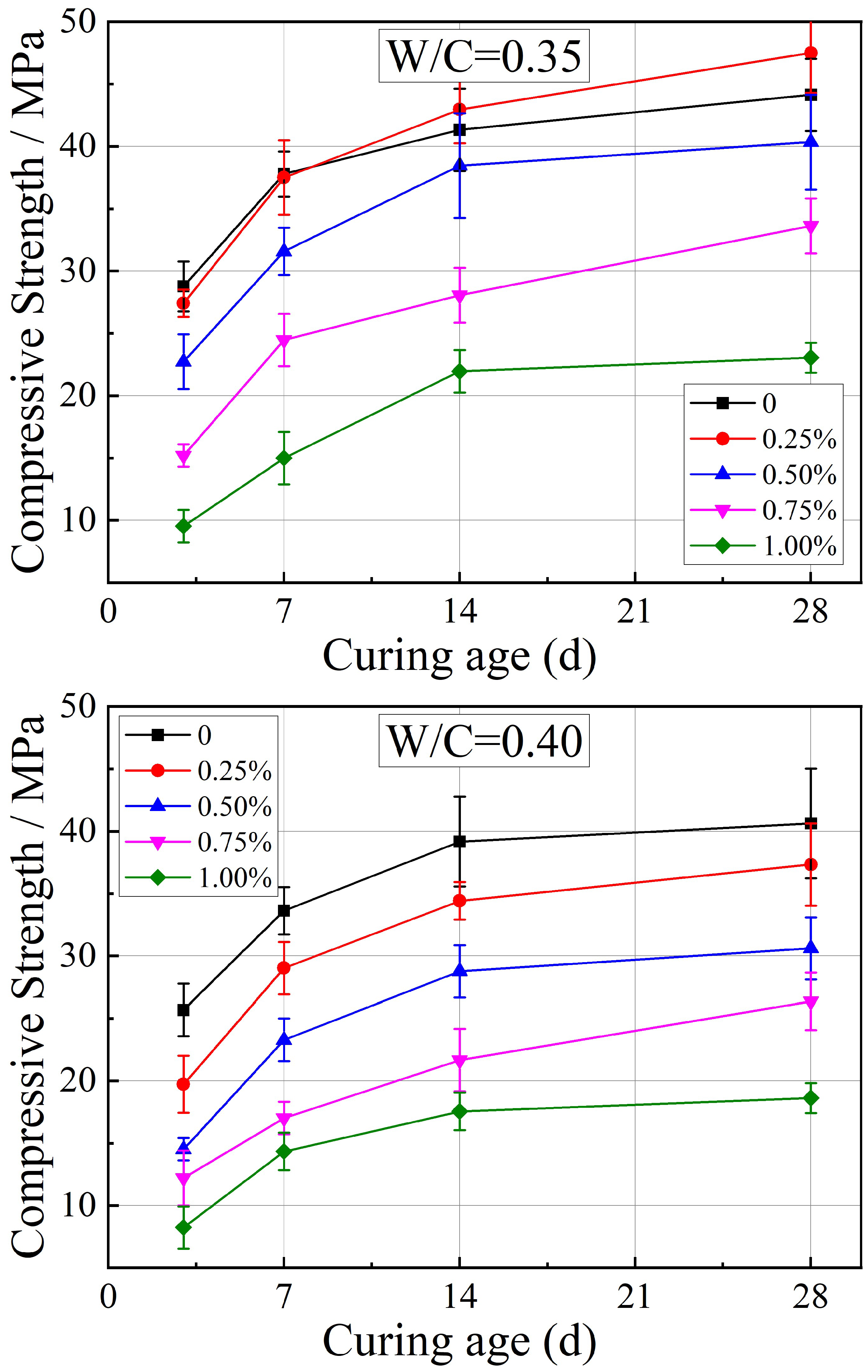



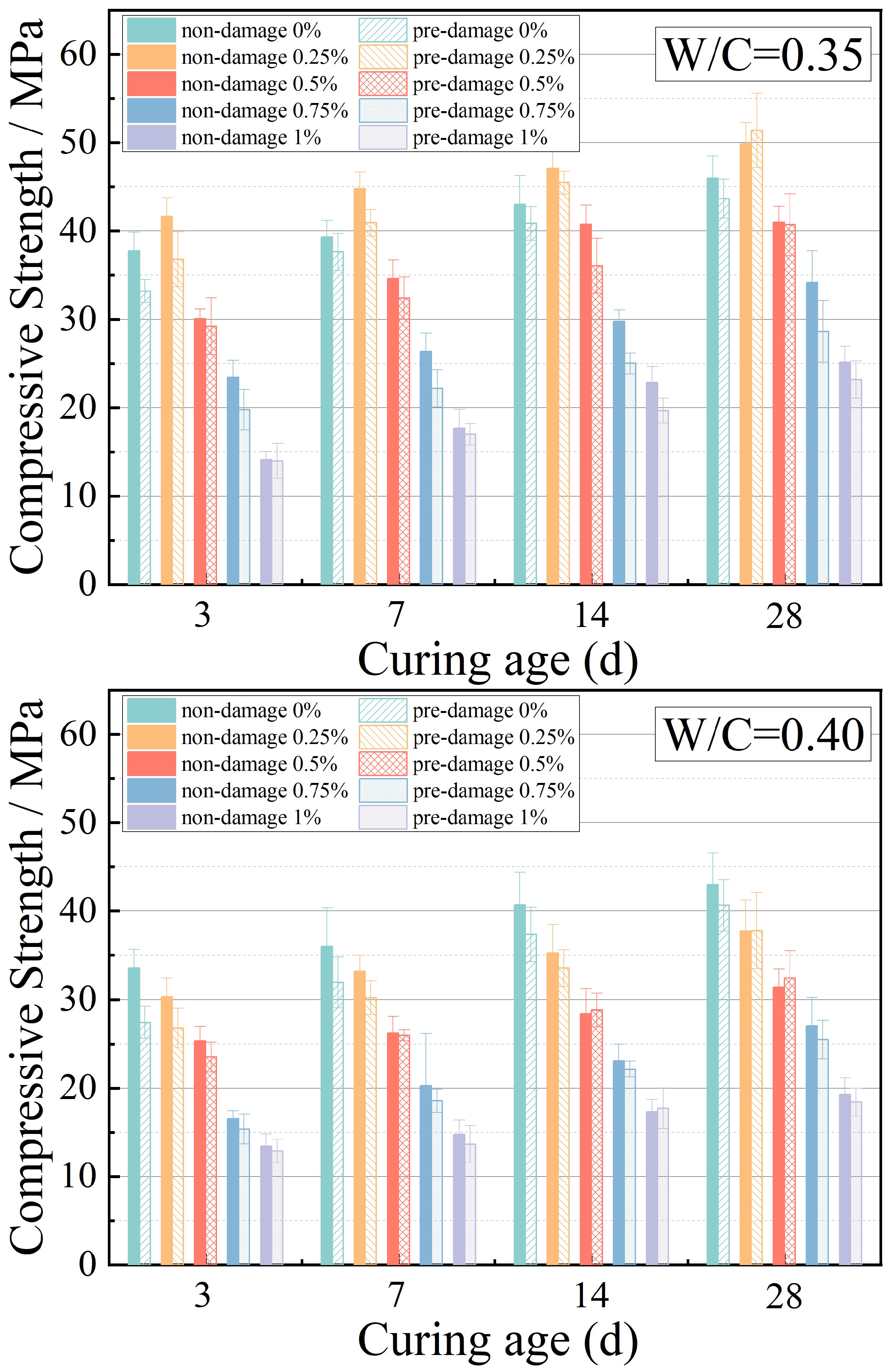
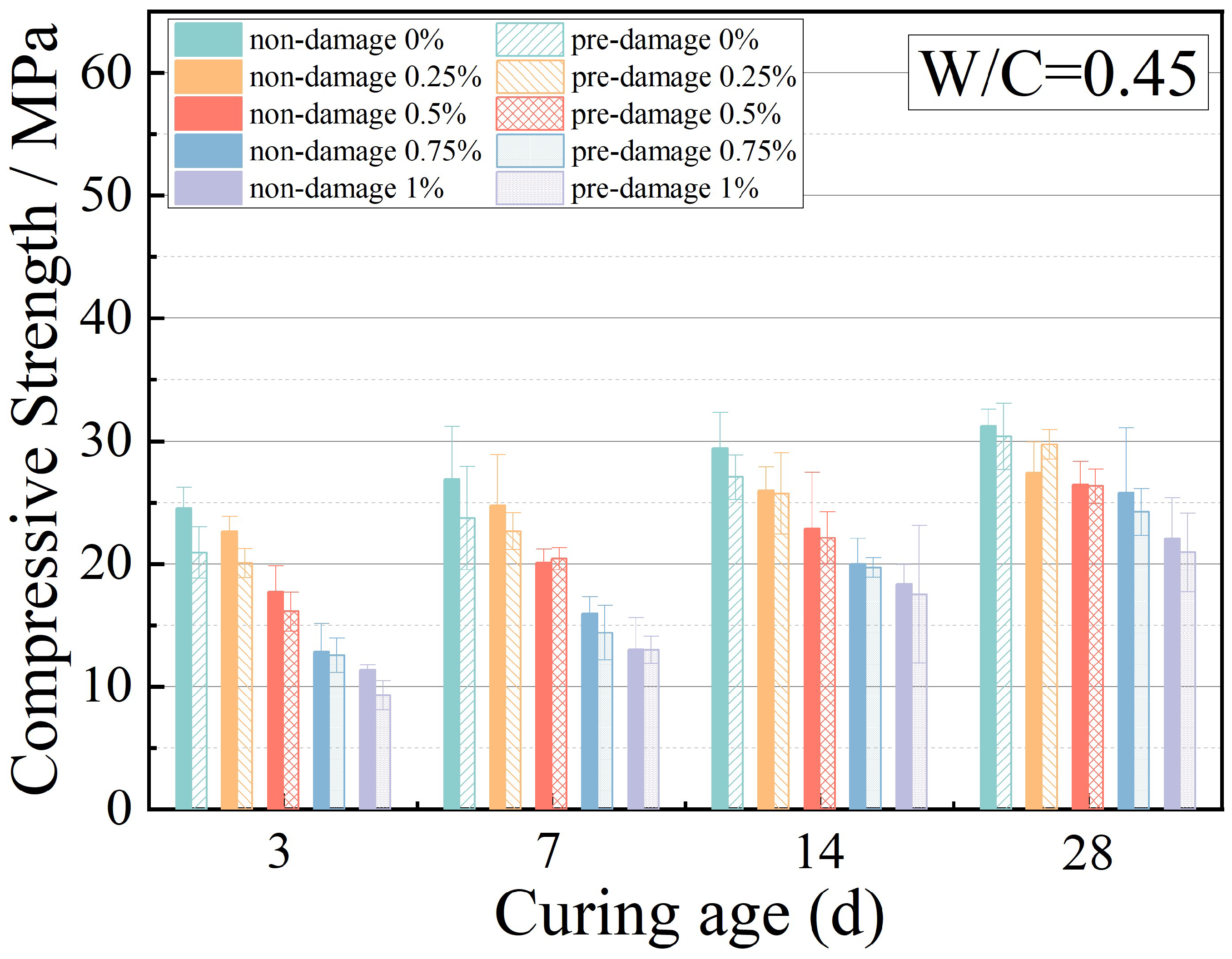


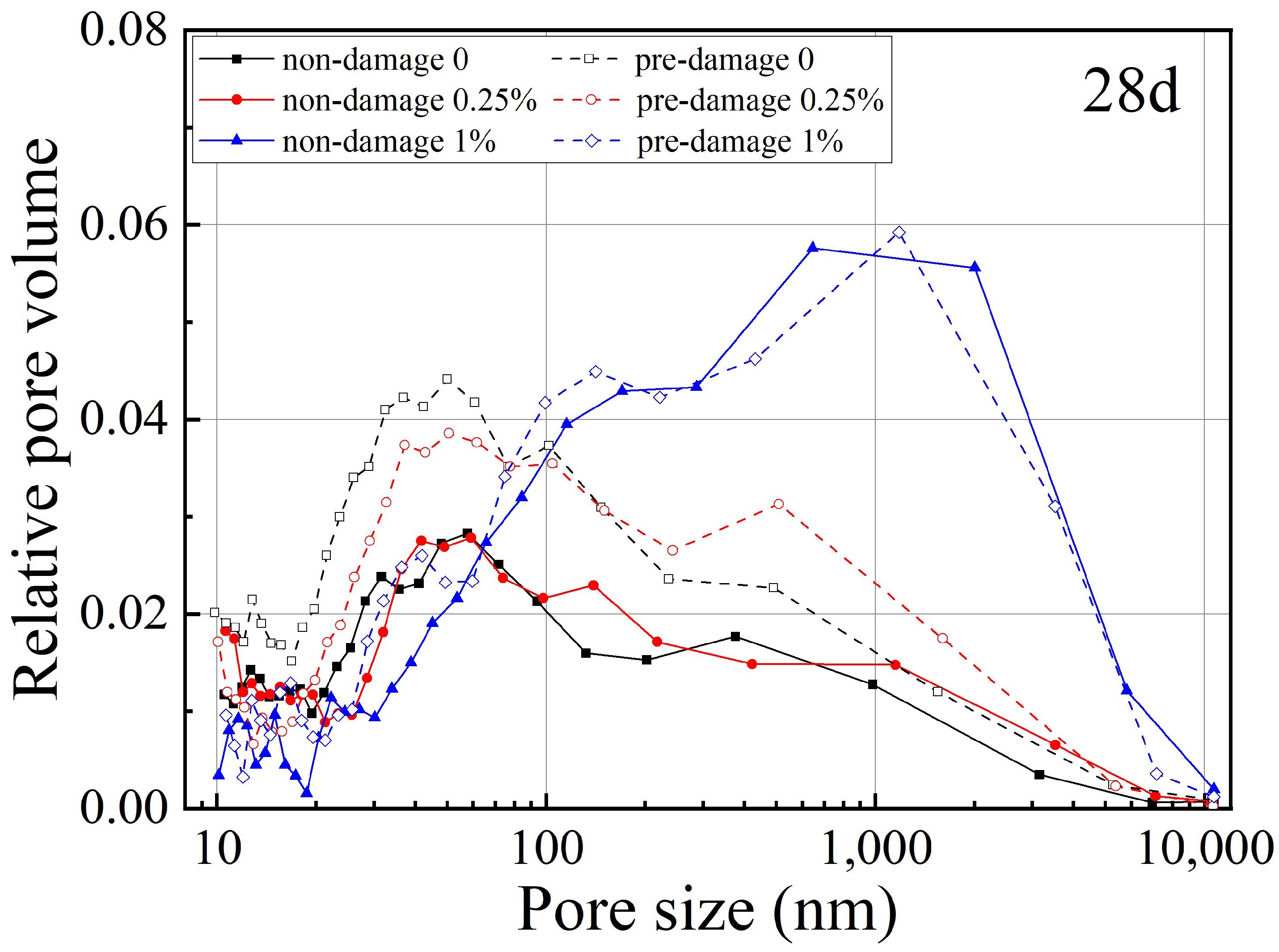




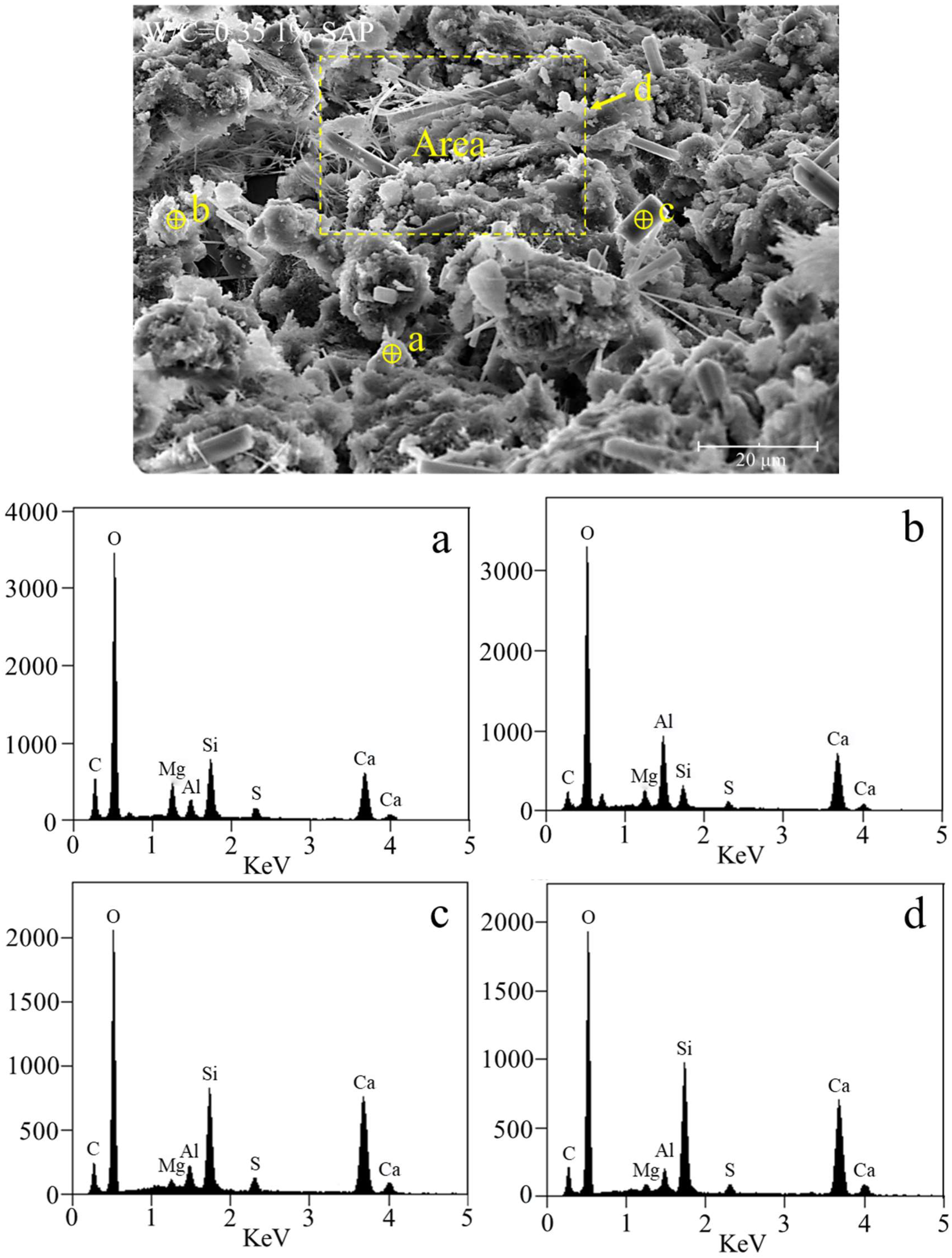
| Chemical Composition | SiO2 | Fe2O3 | Al2O3 | CaO | MgO | SO3 | Loss on Ignition |
|---|---|---|---|---|---|---|---|
| Contents (wt.%) | 19.45 | 4.42 | 5.84 | 63.31 | 4.38 | 2.6 | 0.56 |
| Element | C | O | Na | Si | S | Others |
|---|---|---|---|---|---|---|
| Contents (wt.%) | 22.16 | 49.25 | 21.67 | 1.78 | 3.31 | 1.83 |
| D10 (μm) | D50 (μm) | D90 (μm) | Absorption Capacity (g/g) | Absorption Time (S) | |
|---|---|---|---|---|---|
| SAP | 161.73 ± 1.82 | 217.53 ± 1.69 | 296.22 ± 3.97 | 20 ± 1 | 12 ± 2 |
| Sand | 221.47 ± 2.21 | 607.32 ± 4.86 | 1528.91 ± 9.74 | - | - |
| Samples | Industrial Solid Waste Components 1 (wt.%) | SAP Components 2 (wt.%) | Water (wt.%) | |||
|---|---|---|---|---|---|---|
| Cement | Sand | W1 3 | W2 4 | Ws 5 | ||
| 1 | 1 | 2 | 0 | 0.35 | 0 | 0.35 |
| 2 | 1 | 2 | 0.25 | 0.35 | 0.05 | 0.4 |
| 3 | 1 | 2 | 0.5 | 0.35 | 0.1 | 0.45 |
| 4 | 1 | 2 | 0.75 | 0.35 | 0.15 | 0.5 |
| 5 | 1 | 2 | 1 | 0.35 | 0.2 | 0.55 |
| 6 | 1 | 2 | 0 | 0.4 | 0 | 0.4 |
| 7 | 1 | 2 | 0.25 | 0.4 | 0.05 | 0.45 |
| 8 | 1 | 2 | 0.5 | 0.4 | 0.1 | 0.5 |
| 9 | 1 | 2 | 0.75 | 0.4 | 0.15 | 0.55 |
| 10 | 1 | 2 | 1 | 0.4 | 0.2 | 0.6 |
| 11 | 1 | 2 | 0 | 0.45 | 0 | 0.45 |
| 12 | 1 | 2 | 0.25 | 0.45 | 0.05 | 0.5 |
| 13 | 1 | 2 | 0.5 | 0.45 | 0.1 | 0.55 |
| 14 | 1 | 2 | 0.75 | 0.45 | 0.15 | 0.6 |
| 15 | 1 | 2 | 1 | 0.45 | 0.2 | 0.65 |
| SAP(%) | Balshin Equation | σ0 | n | Regression Coefficient | |
|---|---|---|---|---|---|
| non-damage | 0 | 60.28 | 1.86 | 0.89 | |
| 0.25 | 65.28 | 1.82 | 0.93 | ||
| 0.5 | 120.06 | 4.82 | 0.30 | ||
| 0.75 | 64.46 | 3.18 | 0.17 | ||
| 1 | 103.30 | 5.79 | 0.29 | ||
| pre-damage | 0 | 74.24 | 2.99 | 0.54 | |
| 0.25 | 77.43 | 2.58 | 0.50 | ||
| 0.5 | 73.01 | 3.02 | 0.45 | ||
| 0.75 | 45.61 | 2.39 | 0.17 | ||
| 1 | 44.47 | 2.91 | 0.24 |
| C | O | Mg | Al | Si | S | Ca | Others | |
|---|---|---|---|---|---|---|---|---|
| a | 4.93 | 51.20 | 3.64 | 2.26 | 8.59 | 2.51 | 24.05 | 2.82 |
| b | 1.95 | 47.00 | 1.66 | 8.35 | 2.83 | 1.30 | 26.68 | 10.23 |
| c | 2.77 | 45.45 | 0.6 | 1.96 | 10.17 | 2.15 | 36.37 | 0.53 |
| d | 2.63 | 44.88 | 0.46 | 1.70 | 13.03 | 1.38 | 35.18 | 0.76 |
Publisher’s Note: MDPI stays neutral with regard to jurisdictional claims in published maps and institutional affiliations. |
© 2022 by the authors. Licensee MDPI, Basel, Switzerland. This article is an open access article distributed under the terms and conditions of the Creative Commons Attribution (CC BY) license (https://creativecommons.org/licenses/by/4.0/).
Share and Cite
Cheng, B.; Li, X.; Liu, Y.; Chen, M.; Du, S. Effect of Superabsorbent Polymers on the Self-Healing Properties of Pre-Damaged Concrete. Processes 2022, 10, 2333. https://doi.org/10.3390/pr10112333
Cheng B, Li X, Liu Y, Chen M, Du S. Effect of Superabsorbent Polymers on the Self-Healing Properties of Pre-Damaged Concrete. Processes. 2022; 10(11):2333. https://doi.org/10.3390/pr10112333
Chicago/Turabian StyleCheng, Bingchuan, Xiuhao Li, Yankai Liu, Mengjun Chen, and Sanlin Du. 2022. "Effect of Superabsorbent Polymers on the Self-Healing Properties of Pre-Damaged Concrete" Processes 10, no. 11: 2333. https://doi.org/10.3390/pr10112333
APA StyleCheng, B., Li, X., Liu, Y., Chen, M., & Du, S. (2022). Effect of Superabsorbent Polymers on the Self-Healing Properties of Pre-Damaged Concrete. Processes, 10(11), 2333. https://doi.org/10.3390/pr10112333







